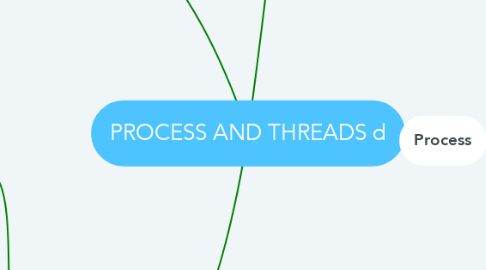
1. Threads
1.1. Single thread approaches
1.1.1. a single thread of execution per process , in which the concept of thread is not recognized is referred to as a single thread approach
1.1.2. example : MS-DOS
1.2. Multithread approaches
1.2.1. a Java run time environment is an example of a system of one process with multiple threads
1.3. each thread has
1.3.1. an execution state
1.3.2. saved thread content when not running
1.3.3. an execution stack
1.3.4. some per-thread static storage for local variables
1.3.5. access to memory and resources if its process
1.4. benefits
1.4.1. takes less time to create a new thread than a process
1.4.2. less time to terminate a thread than a process
1.4.3. switching between two threads takes less time than a process
1.4.4. threads enhance efficiency in communication between program
2. Resource ownership
2.1. Process includes a virtual address space to hold the process image
2.1.1. the OS performs a protection function to prevent unwanted interference between a processes with respect to resources
3. Scheduling execution
3.1. Follows an execution path that may be interleaved with other process
3.1.1. a process has an execution state (Running , Ready , etc.) and a dispatching priority and is scheduled and dispatched by OS
4. Process
4.1. Process control blocks
4.1.1. contain the process element
4.1.1.1. identifier
4.1.1.2. state
4.1.1.3. priority
4.1.1.4. memory pointers
4.1.1.5. program counter
4.1.1.6. context data
4.1.1.7. accounting information
4.1.1.8. I/O states
4.2. Process states
4.2.1. Trace
4.2.1.1. can be characterized by showing how the traces of the various processes are interleaved
4.2.1.2. behavior of individual process by listing the sequence of instructions that execute for that process
4.2.2. Dispatcher
4.2.2.1. small program that switches the processor from one process to another
4.3. Two-States process model
4.3.1. a process may be in one of two states
4.3.1.1. running
4.3.1.2. not running
4.4. Five-State process model
4.5. Process Creations
4.5.1. occurs when a new process is to be added to those currently being managed
4.5.2. reasons
4.5.2.1. new batch job
4.5.2.2. interaction logon
4.5.2.3. created by OS to provide a service
4.5.2.4. spawned by existing process
4.6. Process spawning
4.6.1. when the OS creates the process at the explicit request of another process
4.7. Parent process
4.7.1. is the original creating process
4.8. Child process
4.8.1. is the new process
4.9. Process Termination
4.9.1. reason
4.9.1.1. normal completion
4.9.1.2. time limit exceeded
4.9.1.3. memory available
4.9.1.4. arithmetic error
4.9.1.5. bounds violation
4.10. Suspended
4.10.1. swapping
4.10.1.1. involve moving part of all of process from main memory to disk
4.10.2. characteristic of process suspended
4.10.2.1. the process is not immediately available for execution
4.10.2.2. the process may or may not be removed from this state until the agent explicitly orders the removal
4.10.2.3. the process was placed in a suspended state by an agent either itself , a parent process or the OS for the purpose of parenting its execution .
4.10.3. reasons
4.10.3.1. swapping
4.10.3.2. other OS reason
4.10.3.3. interactive user request
4.10.3.4. parent process request

